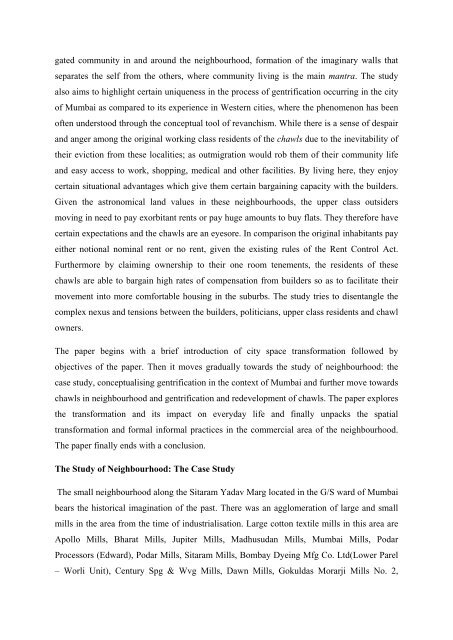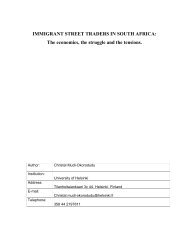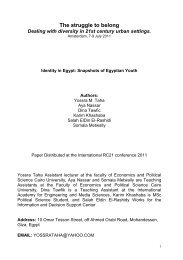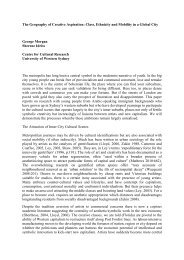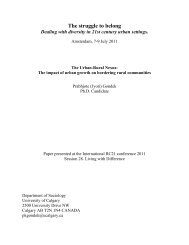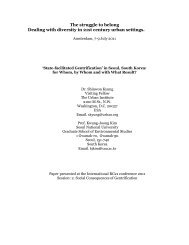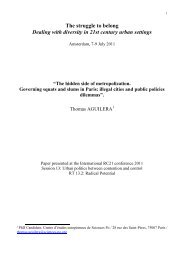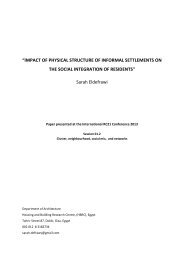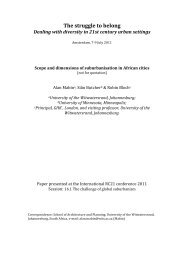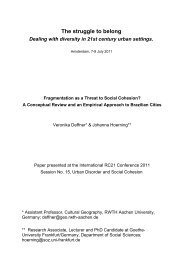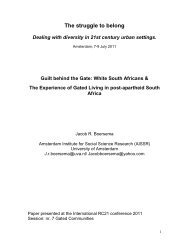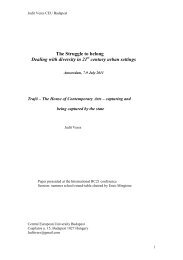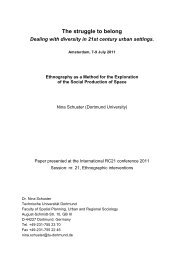Gentrification in the mill land areas of Mumbai city - RC21 ORG ...
Gentrification in the mill land areas of Mumbai city - RC21 ORG ...
Gentrification in the mill land areas of Mumbai city - RC21 ORG ...
You also want an ePaper? Increase the reach of your titles
YUMPU automatically turns print PDFs into web optimized ePapers that Google loves.
gated community <strong>in</strong> and around <strong>the</strong> neighbourhood, formation <strong>of</strong> <strong>the</strong> imag<strong>in</strong>ary walls that<br />
separates <strong>the</strong> self from <strong>the</strong> o<strong>the</strong>rs, where community liv<strong>in</strong>g is <strong>the</strong> ma<strong>in</strong> mantra. The study<br />
also aims to highlight certa<strong>in</strong> uniqueness <strong>in</strong> <strong>the</strong> process <strong>of</strong> gentrification occurr<strong>in</strong>g <strong>in</strong> <strong>the</strong> <strong>city</strong><br />
<strong>of</strong> <strong>Mumbai</strong> as compared to its experience <strong>in</strong> Western cities, where <strong>the</strong> phenomenon has been<br />
<strong>of</strong>ten understood through <strong>the</strong> conceptual tool <strong>of</strong> revanchism. While <strong>the</strong>re is a sense <strong>of</strong> despair<br />
and anger among <strong>the</strong> orig<strong>in</strong>al work<strong>in</strong>g class residents <strong>of</strong> <strong>the</strong> chawls due to <strong>the</strong> <strong>in</strong>evitability <strong>of</strong><br />
<strong>the</strong>ir eviction from <strong>the</strong>se localities; as outmigration would rob <strong>the</strong>m <strong>of</strong> <strong>the</strong>ir community life<br />
and easy access to work, shopp<strong>in</strong>g, medical and o<strong>the</strong>r facilities. By liv<strong>in</strong>g here, <strong>the</strong>y enjoy<br />
certa<strong>in</strong> situational advantages which give <strong>the</strong>m certa<strong>in</strong> barga<strong>in</strong><strong>in</strong>g capa<strong>city</strong> with <strong>the</strong> builders.<br />
Given <strong>the</strong> astronomical <strong>land</strong> values <strong>in</strong> <strong>the</strong>se neighbourhoods, <strong>the</strong> upper class outsiders<br />
mov<strong>in</strong>g <strong>in</strong> need to pay exorbitant rents or pay huge amounts to buy flats. They <strong>the</strong>refore have<br />
certa<strong>in</strong> expectations and <strong>the</strong> chawls are an eyesore. In comparison <strong>the</strong> orig<strong>in</strong>al <strong>in</strong>habitants pay<br />
ei<strong>the</strong>r notional nom<strong>in</strong>al rent or no rent, given <strong>the</strong> exist<strong>in</strong>g rules <strong>of</strong> <strong>the</strong> Rent Control Act.<br />
Fur<strong>the</strong>rmore by claim<strong>in</strong>g ownership to <strong>the</strong>ir one room tenements, <strong>the</strong> residents <strong>of</strong> <strong>the</strong>se<br />
chawls are able to barga<strong>in</strong> high rates <strong>of</strong> compensation from builders so as to facilitate <strong>the</strong>ir<br />
movement <strong>in</strong>to more comfortable hous<strong>in</strong>g <strong>in</strong> <strong>the</strong> suburbs. The study tries to disentangle <strong>the</strong><br />
complex nexus and tensions between <strong>the</strong> builders, politicians, upper class residents and chawl<br />
owners.<br />
The paper beg<strong>in</strong>s with a brief <strong>in</strong>troduction <strong>of</strong> <strong>city</strong> space transformation followed by<br />
objectives <strong>of</strong> <strong>the</strong> paper. Then it moves gradually towards <strong>the</strong> study <strong>of</strong> neighbourhood: <strong>the</strong><br />
case study, conceptualis<strong>in</strong>g gentrification <strong>in</strong> <strong>the</strong> context <strong>of</strong> <strong>Mumbai</strong> and fur<strong>the</strong>r move towards<br />
chawls <strong>in</strong> neighbourhood and gentrification and redevelopment <strong>of</strong> chawls. The paper explores<br />
<strong>the</strong> transformation and its impact on everyday life and f<strong>in</strong>ally unpacks <strong>the</strong> spatial<br />
transformation and formal <strong>in</strong>formal practices <strong>in</strong> <strong>the</strong> commercial area <strong>of</strong> <strong>the</strong> neighbourhood.<br />
The paper f<strong>in</strong>ally ends with a conclusion.<br />
The Study <strong>of</strong> Neighbourhood: The Case Study<br />
The small neighbourhood along <strong>the</strong> Sitaram Yadav Marg located <strong>in</strong> <strong>the</strong> G/S ward <strong>of</strong> <strong>Mumbai</strong><br />
bears <strong>the</strong> historical imag<strong>in</strong>ation <strong>of</strong> <strong>the</strong> past. There was an agglomeration <strong>of</strong> large and small<br />
<strong>mill</strong>s <strong>in</strong> <strong>the</strong> area from <strong>the</strong> time <strong>of</strong> <strong>in</strong>dustrialisation. Large cotton textile <strong>mill</strong>s <strong>in</strong> this area are<br />
Apollo Mills, Bharat Mills, Jupiter Mills, Madhusudan Mills, <strong>Mumbai</strong> Mills, Podar<br />
Processors (Edward), Podar Mills, Sitaram Mills, Bombay Dye<strong>in</strong>g Mfg Co. Ltd(Lower Parel<br />
– Worli Unit), Century Spg & Wvg Mills, Dawn Mills, Gokuldas Morarji Mills No. 2,


